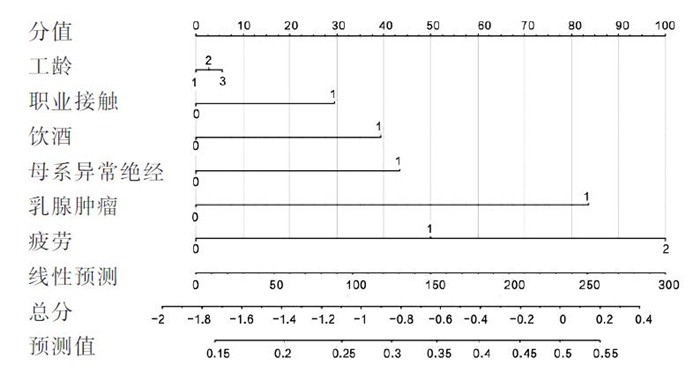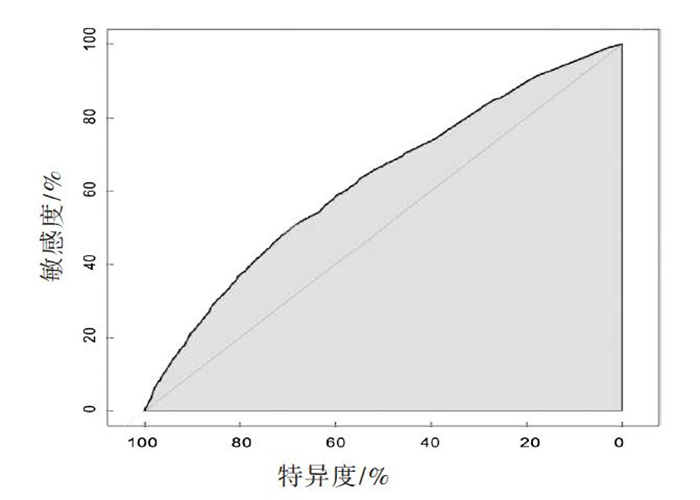Analysis of the influencing factors and risk nomogram model of reproductive tract infection of female workers in petrochemical industry
-
+ English摘要:目的 建立石油化工企业女性职工生殖道感染风险的列线图模型,分析该行业女工生殖健康的影响因素。方法 选择某石油化工企业所有的5 186名女性职工作为研究对象,进行现场和问卷调查,分析石油化工企业的职业病危害因素,以及女性职工的疲劳情况和生殖道感染发生率,并采用多因素logistic回归和列线图预测模型揭示生殖道感染的危险因素和影响程度。结果 共发放问卷5 186份,回收有效问卷5 132份,问卷有效率为98.96%。该大型国有石油化工企业主要职业病危害因素包括有机溶剂、粉尘、有毒气体、电磁辐射、噪声等。调查女工中近6个月内存在生殖道感染的1 241人(占24.18%)。logistic回归分析结果显示:工龄10 ~ 19年、职业接触有害因素、有饮酒习惯、母系亲属存在过早或过晚绝经、患有乳腺肿瘤、存在躯体疲劳以及脑力疲劳是女工出现生殖道感染的危险因素(OR =1.300、1.220、1.363、1.384、1.864、1.515、2.049,P < 0.05)。基于多因素回归结果建立的石油化工行业女工生殖道感染的列线图模型的C-index指数为0.626(95%CI为0.608 ~ 0.644)。结论 石油化工行业女工生殖道健康受不良生活方式、遗传、职业有害因素接触、疲劳程度等多种因素影响;建立的列线图预测模型有良好的精准度和区分度,有助于提高石化行业女工的生殖健康风险的评估效能。应采取针对性的管理措施、预防手段和职业健康教育来降低女工生殖道感染的患病水平,促进石油化工行业女工的职业健康。
-
职业性哮喘(occupational asthma,OA)是由于接触职业环境中的致喘物质后引起的支气管哮喘,其发病率占哮喘总人数的2% ~ 15% [1]。异氰酸酯类化合物是有机合成的重要中间体,是最常见的一种致喘物,异氰酸酯所致哮喘可发生于接触后数周到数年后,哮喘反应可呈速发、迟发或双相反应,但在哮喘发作前,部分研究对象呈现隐匿状态。目前在接触致喘物的作业人员职业健康监护中,以胸部X线摄片和肺功能检测为主要检查手段,但这些方法并不能早期发现职业性哮喘,尤其是对于肺功能正常、临床症状不典型的哮喘病人,更加难以识别。因此探讨如何早期筛查出职业性哮喘是非常有必要的。
一氧化氮(nitric oxide,NO)是人体内重要的生理递质,能够反映呼吸系统疾病炎症反应及氧化应激变化程度,尤其是嗜酸性粒细胞气道炎症。有研究[2]表明,呼出气一氧化氮(fractional exhaled nitric oxide,FeNO)浓度与支气管高反应性、支气管舒张可逆性有良好的相关性,能反映气道炎症水平。《全球哮喘管理和预防策略》(Global Initiative for Asthma,GINA)[3]及我国《支气管哮喘防治指南》 [4]也把FeNO与痰液炎症细胞检测一起列入哮喘气道炎症的无创标志物。FeNO检测是一种无创检查且操作简单、可重复性好、有较高的特异性及灵敏度。本研究旨在通过检测FeNO水平,研究异氰酸酯接触人员呼吸道炎症水平,分析FeNO与肺功能的关系,探讨FeNO在职业健康监护和职业性哮喘早期诊断中的应用。
1. 对象与方法
1.1 研究对象
2016年1月—2017年12月,选择上海市某两家新型材料生产企业接触异氰酸酯的192名作业工人为接触组,接触组纳入的研究对象接触异氰酸酯作业工龄均超过1年。另选择某家物流企业不接触职业病危害因素的91名年龄、性别构成相近的办公、后勤人员作为对照组。研究对象排除标准:(1)除哮喘外合并有其他呼吸系统疾病;(2)有其他系统的严重疾病(如心肌梗死、恶性肿瘤等);(3)服用过硝酸酯类相关药物;(4)近期有上呼吸道感染者;(5)吸烟者。本研究经上海市化工职业病防治院医学伦理委员会审查通过,并得到研究对象知情同意。
1.2 研究方法
1.2.1 资料收集
收集研究对象基本信息,包括姓名、性别、年龄、职业接触史、既往史、相关疾病家族史、吸烟史。职业健康检查:包括问诊、体格检查、血和尿常规、嗜酸性粒细胞计数、肝功能、心电图、肺功能、胸部X线摄片以及FeNO测定。
1.2.2 FeNO测定
采用无锡尚沃医疗电子股份有限公司生产的纳库仑呼出气一氧化氮检测系统仪P100,由经过专业技术培训、具有仪器操作资格的专业技术人员负责操作,按照美国胸科学会/欧洲呼吸学会(American Thoracic Society/European Respiratory Society,ATS/ERS)2005年提出的关于NO测定技术和测定程序标准的推荐意见,要求研究对象在平静的状态下,先尽量呼出肺内气体,再用口唇包紧口含器用力吸气5 s,然后以50 mL/s的流速平稳呼出肺内气体,排气时间持续10 s,系统自动分析读取数值,测定结果以ppb(1 ppb = 1 × 10-9)为计量单位。测试前1 h内禁烟、禁食。FeNO检测在肺功能之前,两者间隔0.5 h。异氰酸酯接触组作业人员以班前检测FeNO为准。
FeNO值选取:根据2011年美国胸科学会发表的呼出气一氧化氮临床应用指南,FeNO < 25 ppb为非嗜酸性炎症,25 ~ 50 ppb为可疑嗜酸性炎症, > 50 ppb为嗜酸性炎症[2]。
1.2.3 肺功能测定
采用意大利MIR公司spirolab Ⅲ型肺功能仪,由经过专业技术培训、具有仪器操作资格的专业技术人员负责操作,严格掌握质量控制标准,减少人为误差因素。操作重复测试3次,每次数值变化不超过5%,取最佳值。主要检测指标为用力肺活量(forced vital capacity,FVC)、第一秒用力呼气量(forced expiratory volume in first second,FEV1)、第一秒用力呼气量占用力肺活量的百分比(FEV1/FVC)。测定结果以实测值占预计值的百分比表示,已校正性别、年龄、身高、体质量等因素的影响。
1.2.4 沙丁胺醇支气管舒张试验
对FeNO测定值> 50 ppb者,参考肺功能结果行支气管舒张试验。参照中华医学会呼吸病学分会肺功能专业组制定的支气管舒张试验指南要求[5]进行沙丁胺醇支气管舒张试验。支气管舒张药物为400 μg沙丁胺醇气雾剂。先测定基础肺功能,然后吸入沙丁胺醇气雾剂400 μg,15 min后测定FEV1,如果吸入沙丁胺醇后FEV1改善率超过12%或以上,或FEV1绝对值增加 > 200 mL,则判断为支气管舒张试验阳性。
1.2.5 作业场所危害因素检测
通过查阅企业作业场所环境检测报告,收集工作场所基础资料:工艺流程、近5年作业场所职业病危害因素检测结果、作业人员接触时间和防护措施等。职业病危害因素超标与否按照GBZ 2.1—2019《工作场所有害因素职业接触限值第1部分:化学有害因素》 [6]判定。
1.2.6 统计学分析
应用EpiData 3.1软件进行数据录入,用SPSS 21.0软件进行统计学处理。计数资料以率表示;符合正态分布的计量资料采用均数±标准差(x ± s)表示,两组间差异比较采用独立样本t检验。检验水准为α = 0.05。
2. 结果
2.1 一般资料
接触组研究对象主要接触甲苯-2,4-二异氰酸酯(toluene diisocyanate,TDI)、二苯基甲烷二异氰酸酯(4,4'-diphenylmethane diisocyanate,MDI)和1,6-己二异氰酸酯(1, 6-diisocyanatohexane,HDI),接触组男73人,女119人,平均年龄(35.61 ± 6.84)岁,平均接害工龄(5.29 ± 3.99)年;对照组男28人,女63人,平均年龄(34.32 ± 4.59)岁。两组性别差异无统计学意义(χ2 = 1.415,P > 0.05),年龄差异亦无统计学意义(t = 1.863,P > 0.05)。
2.2 作业场所异氰酸酯检测结果
接触组接触的TDI时间加权平均容许浓度(PC-TWA)为0.1 mg/m3,MDI为0.05 mg/m3,HDI为0.03 mg/m3。用人单位按照规定开展作业场所职业病危害因素定期检测,收集近5年的作业场所检测报告显示TDI的时间加权平均浓度(CTWA)为0.002 ~ 0.044 mg/m3,MDI的CTWA均 < 0.015 mg/m3,HDI的CTWA均 < 0.004 mg/m3,合格率为100%。工人日常工作中均穿戴防毒口罩、防护手套和工作服。
2.3 肺功能与异氰酸酯接触的关系
2.3.1 两组人员肺功能比较
比较接触组和对照组的肺功能的各项指标(均以占预计值的百分比计),结果显示接触组的FVC、FEV1检测值均高于对照组,FEV1/FVC低于对照组,差异均有统计学意义(P < 0.001)。见表 1。
表 1 接触组和对照组肺功能比较(x ± s) 组别 人数 FVC/% FEV1/% FEV1/FVC/% 接触组 192 97.30 ± 15.26 98.60 ± 14.34 86.77 ± 6.21 对照组 91 89.24 ± 9.72 93.24 ± 10.04 89.60 ± 4.98 t值 5.375 3.633 - 4.110 P值 < 0.001 < 0.001 < 0.001 2.3.2 不同接害工龄工人肺功能情况
将接触组人员按接害工龄分成≥ 7年组和 < 7年组,观察两组人员肺功能指标的差异。两组人员FVC、FEVl差异均无统计学意义(P > 0.05), < 7年组FEVl/FVC高于≥7年组,差异有统计学意义(P < 0.05)。
表 2 接触组不同接害工龄工人肺功能比较(x ± s) 接害工龄/年 人数 FVC/% FEV1/% FEV1/FVC/% < 7 146 97.76 ± 14.98 98.75 ± 13.62 87.46 ± 5.52 ≥ 7 46 95.86 ± 16.18 98.13 ± 16.56 85.53 ± 4.05 t值 0.736 0.256 2.567 P值 0.463 0.798 0.012 2.4 不同特征研究对象FeNO检测结果
2.4.1 FeNO与性别、年龄的关系
两组研究对象中,男性合计101人,女性182人。男性FeNO检测值为(22.39 ± 12.01)ppb,高于女性的(17.10 ± 8.98)ppb,差异有统计学意义(t = 3.771,P < 0.01)。进一步按照年龄分成3组,不同年龄研究对象FeNO检测值差异无统计学意义(P > 0.05)。见表 3。
表 3 不同年龄研究对象FeNO检测值比较(x ± s) 年龄/岁 人数 FeNO/ppb ≤ 29 57 18.68 ± 10.40 30~39 150 18.34 ± 10.10 ≥ 40 76 20.50 ± 11.72 F值 1.067 P值 0.345 2.4.2 异氰酸酯接触与FeNO检测结果的关系
接触组FeNO检测值为(19.39 ± 9.49)ppb,对照组为(18.16 ± 12.70)ppb,差异无统计学意义(t = 0.815,P > 0.05)。将接触组按接害工龄分成≥ 7年组和 < 7年组,结果显示:≥ 7年组FeNO检测值为(19.87 ± 9.49)ppb,<7年组为(18.16 ± 12.70)ppb,差异无统计学意义(t = 0.815,P > 0.05)。
2.5 FeNO与肺功能的关系
以FeNO检测值25 ppb为分界点,将所有人分成两组,分析不同FeNO水平下肺功能的差异情况,结果显示两组人群肺功能各项指标差异均无统计学意义(P > 0.05)。见表 4。
表 4 不同FeNO水平的研究对象肺功能比较FeNO/ppb 人数 FVC/% FEV1/% FEV1/FVC/% < 25 219 94.91 ± 14.39 97.43 ± 13.68 87.63 ± 6.01 ≥ 25 64 94.03 ± 13.67 95.01 ± 11.96 86.17 ± 5.66 t值 - 0.204 0.159 1.732 P值 0.838 0.874 0.084 2.6 支气管舒张试验
192名接触组工人中,有13名人员FeNO检测值高于50 ppb,这13人中,除3人检测期间有感冒咳嗽、1人肺功能高于预测值而无法行支气管舒张试验外,余下9人中肺功能正常8人,1人有轻度阻塞性通气功能障碍。虽然常规支气管舒张试验的指征是肺功能异常(FEV1 < 70%或FEV1/FVC < 70%),但研究显示支气管舒张试验有助于肺通气功能异常疑似研究对象的诊断[7],因此9人均行支气管舒张试验,其中1人证实已诊断为支气管哮喘,剩余8人中2人支气管舒张试验阳性,6人阴性,阳性率33.3%。
3. 讨论
职业性哮喘是由于接触职业病危害因素而引起的哮喘,异氰酸酯是职业性哮喘中最常见的致喘物之一,其所致哮喘存在接触剂量-反应关系,低浓度接触也可导致哮喘发生[1]。本次研究中接触组作业人员接触的TDI、MDI和HDI均远低于我国职业接触限值,为低浓度接触人群。1989年NOISH建议将工作场所TDI控制在尽可能低的水平[8],美国工业卫生协会2015年将工作场所TDI的PC-TWA规定为0.007 mg/m3 [9],探讨低浓度接触异氰酸酯作业人员气道炎症水平及肺功能状况,有助于为接触异氰酸酯作业人员职业病防治提供科学依据。
既往研究表明,长期接触低浓度TDI可导致肺功能下降[10],本研究结果显示接触低浓度TDI、MDI、HDI的作业人员肺功能各项指标与对照组有显著差异,但是与以往结果不同的是,接触组FVC、FEV1高于对照组(P < 0.01),可能与接触组为体力劳动者而对照组为非体力劳动者有关,有研究[11]表明体力劳动者用力肺活量较非体力劳动者高。而接触组FEV1/FVC明显低于对照组,且随接害工龄的延长有降低的趋势(P < 0.01),由此可见,在长期低浓度接触下,FEV1/FVC这一指标能更好地反映异氰酸酯类致喘物对肺功能的影响。
《全球哮喘管理和预防策略》和我国《支气管哮喘防治指南》定义支气管哮喘是一种过敏性疾病,是由多种细胞(包括嗜酸性粒细胞、肥大细胞、T淋巴细胞、中性粒细胞、平滑肌细胞、气道上皮细胞以及细胞组分)参与引起的气道慢性炎症性疾病。FeNO作为反映支气管过敏性炎症水平的指标,被作为治疗、观察支气管哮喘的指标。而目前国内有关FeNO在职业性哮喘的诊断治疗中的应用的研究较少。本次研究结果显示:接触低浓度异氰酸酯的作业人员FeNO水平和对照组差异并无统计学意义(P > 0.05);接触组人员随着接害工龄的增加,FeNO水平也未见增高(P > 0.05)。提示低浓度接触异氰酸酯并不会影响作业人员的FeNO水平,与国外多项研究结果[12-14]基本一致。根据Jonaid等[15]的研究,FeNO水平更可能与个体特异质有关,尤其是异氰酸酯特异性IgE(sIgE)阳性的观察对象的FeNO水平明显升高(P < 0.05),而与异氰酸酯sIgG阳性无关。由此可见,低浓度接触时FeNO不能反映支气管哮喘发病情况也是完全有可能的。
对于FeNO水平与肺功能的关系,Olivieri等[16]的研究表明FeNO水平与肺功能无关。Malmberg等[17]对114名健康的非特异质学龄儿童进行了一项研究,表明FeNO水平与FEV1和FVC绝对值有关,但当肺功能按预测百分比表示时则无相关性。Kovesi等[18]也注意到,肺功能绝对值与对数转化的FeNO有相关性。本研究按照美国胸科学会(ATS)发表的FeNO临床应用指南的分级,将FeNO水平按照≥ 25 ppb和 < 25 ppb分为两组,结果发现两组间的肺功能各项指标差异无统计学意义(P > 0.05),提示低浓度接触异氰酸酯作业人员的FeNO水平与肺功能占预计值的百分比无相关性。另外本研究在检出的FeNO > 50 ppb的9人中,只有1人FEV1低于80%,其余均为正常,表明FeNO水平升高与肺功能改变并不平行。
对于FeNO作为职业接触致喘物作业人员职业健康筛查指标的探讨,近年来国内外的研究人员做了大量研究。Florentin等[19]使用FeNO筛查面包师、糕点制造师和理发师中的OA的高风险人群,发现FeNO单独使用时敏感性为78.9%,特异性为42.8%,而结合呼吸系统调查问卷可使特异性提升为80.5%,而敏感性保持不变,所以认为FeNO检测结合呼吸系统调查问卷有助于OA的筛查。Barbinova等[20]通过研究与吸入异氰酸酯激发试验相关的特异性哮喘反应和非特异性支气管高反应性(bronchial hyperresponsiveness,BHR)者的FeNO水平变化(△FeNO),来预测异氰酸酯接触人员临床和亚临床反应,结果认为FeNO测定结果受多种因素的影响,△FeNO比基线FeNO具有更高的预测价值,尤其对于亚临床表现者,支气管气道高反应阳性合并吸入异氰酸酯激发试验后△FeNO升高大于50%为职业接触异氰酸酯致哮喘的高危因素。相似的研究[21-22]显示吸入异氰酸酯激发试验后△FeNO升高 > 13 ppb或17.5 ppb对OA有很高的预测价值。国内杜丽艳等[23]对93例慢性咳嗽研究对象的研究发现FeNO水平 > 34 ppb时,对疑似哮喘的研究对象进行支气管舒张试验,可以更全面地反映气道阻塞的可逆性,也有利于慢性咳嗽病因的筛查。由于条件限制,本研究未能对FeNO在25 ~ 50 ppb之间的研究对象进行支气管舒张试验,只对FeNO > 50 ppb的9人进行了支气管舒张试验,其中1例已诊断支气管哮喘,2例支气管舒张试验阳性,检出率为33.3%,而9人中只有1例肺功能异常。由此可以看出,FeNO水平升高要早于肺功能改变。由于FeNO水平升高受较多因素影响,因此FeNO不适宜单独用作诊断指标,但作为筛查指标,联合支气管舒张试验来诊断与筛查职业性哮喘,它比肺功能有更好的预测价值。
综上所述,长期接触低浓度异氰酸酯类致喘物仍可引起肺功能指标(FEV1/FVC%)的改变;而FeNO水平并不能反映异氰酸酯类致喘物的低水平接触,与肺功能占预计值的百分比也无相关性,但接触异氰酸酯人群支气管舒张试验显示的阳性改变早于肺功能改变。由于FeNO水平升高受较多因素影响,因此FeNO不适宜单独用作诊断指标,有必要进一步研究FeNO联合支气管舒张试验对职业性哮喘的诊断与筛查的应用价值。
作者声明 本文无实际或潜在的利益冲突 -
表 1 近6个月内女工生殖道感染单因素分析
影响因素 无生殖道感染 有生殖道感染 感染率/% χ2值 P值 年龄/岁 17.530 <0.001 <30 164 37 18.4 30 ~ 39 769 281 26.8 40 ~ 49 2 601 846 24.5 ≥ 50 357 77 17.7 饮酒 22.101 <0.001 无 2 378 665 21.9 有 1 513 576 27.6 母系亲属存在过早或过晚绝经 37.923 <0.001 无 2 442 657 21.2 有 1 449 584 28.7 乳腺肿瘤 14.706 <0.001 无 3 826 1 198 23.8 有 65 43 39.8 多囊卵巢综合征 10.817 0.002 无 3 863 1 219 24.0 有 28 22 44.0 子宫内膜异位症或子宫腺肌病 7.112 0.012 无 3 806 1 197 23.9 有 85 44 34.1 卵巢及子宫肿瘤 47.530 <0.001 无 3 832 1 177 23.5 有 59 64 52.0 睡眠时间/h 14.885 <0.001 >6 3 003 891 22.9 ≤ 6 888 350 28.3 工龄/年 9.706 0.008 6 ~ 9 485 122 20.1 10 ~ 19 911 331 26.7 ≥ 20 2 495 788 24.0 职业接触有害因素 28.338 <0.001 无 2 443 674 21.6 有 1 448 567 28.1 日平均工作时间/h 10.541 0.001 ≤ 8 3 496 1 074 23.5 >8 395 167 29.7 搬运重物 9.219 0.002 无 3 296 1 006 23.4 有 595 235 28.3 疲劳 132.702 <0.001 无 2 526 593 19.0 躯体疲劳 659 255 27.9 脑力疲劳 706 393 35.8 表 2 近6个月内女工生殖道感染多因素logistic回归分析
变量 B值 SE值 Wald χ2值 OR值(95%CI值) P值 工龄10 ~ 19年① 0.262 0.133 3.880 1.300(1.001 ~ 1.688) 0.049 接触职业病危害因素② 0.199 0.069 8.255 1.220(1.065 ~ 1.397) 0.004 有饮酒习惯② 0.310 0.067 21.186 1.363(1.195 ~ 1.555) <0.001 母系亲属过早或过晚绝经② 0.325 0.068 22.975 1.384(1.212 ~ 1.581) <0.001 患乳腺肿瘤② 0.623 0.207 9.090 1.864(1.244 ~ 2.795) 0.003 躯体疲劳② 0.415 0.089 21.801 1.515(1.272 ~ 1.803) <0.001 脑力疲劳② 0.717 0.083 74.070 2.049(1.740 ~ 2.412) <0.001 注:①OR值以工龄6 ~ 9年为参照组得出;②OR值以对应影响因素的“无”为参照组得出。 -
[1] 杨浩峰, 时瑛, 何华. 乌鲁木齐市石油化工行业女工职业卫生知识知晓情况调查[J]. 职业与健康, 2018, 34(21): 2959-2962. https://www.cnki.com.cn/Article/CJFDTOTAL-ZYJK201821021.htm [2] 寇振霞, 寇嘉宁, 俞文兰, 等. 石油化工行业主要职业危害现状分析[J]. 中国工业医学杂志, 2019, 32(5): 378-380. https://www.cnki.com.cn/Article/CJFDTOTAL-SOLE201905015.htm [3] 于常艳, 俞文兰, 徐茗, 等. 全国四省八个行业女职工职业模式与生殖健康相关性研究[J]. 中国工业医学杂志, 2019, 32(4): 252-255. https://www.cnki.com.cn/Article/CJFDTOTAL-SOLE201904005.htm [4] 姚斐, 房敏, 朱高峰, 等. 经穴推拿对慢性疲劳综合征FS-14与FAI评分的影响[J]. 南京中医药大学学报, 2012, 28(3): 222-224. doi: 10.3969/j.issn.1000-5005.2012.03.008 [5] 陈俐, 朱玲, 于辉兰, 等. 生殖道感染病原菌分布及影响因素分析[J]. 中华医院感染学杂志, 2018, 28(6): 915-917;925. https://www.cnki.com.cn/Article/CJFDTOTAL-ZHYY201806031.htm [6] JØRGENSEN T N. Sex disparities in the immune response[J]. Cell Immunol, 2015, 2(294): 61-62.
[7] 庞芬, 张文昌. 有机溶剂对雌(女)性生殖毒理学研究现状[J]. 海峡预防医学杂志, 2008, 14(5): 17-19. doi: 10.3969/j.issn.1007-2705.2008.05.006 [8] BALISE V D, CORNELIUS-GREEN J N, PARMENTER B, et al. Developmental exposure to a mixture of unconventional oil and gas chemicals increased risk-taking behavior, activity and energy expenditure in aged female mice after a metabolic challenge[J]. Front Endocrinol (Lausanne), 2019, 460(10): 2-13.
[9] SAPOUCKEY S A, KASSOTIS C D, NAGEL S C, et al. Prenatal exposure to unconventional oil and gas operation chemical mixtures altered mammary gland development in adult female mice[J]. Endocrinology, 2018, 159(3): 1277-1289. doi: 10.1210/en.2017-00866
[10] GIOVANNA P, MASSIMO L, SARA D T, et al. The estrogen-macrophage interplay in the homeostasis of the female reproductive tract[J]. Hum Reprod Update, 2018, 24(6): 652-672. doi: 10.1093/humupd/dmy026
[11] 梁红, 梁丹玉, 黎海红, 等. 广西10家水泥企业职业性噪声接触女工妇科疾病调查[J]. 职业与健康, 2019, 35(16): 2169-2172. https://www.cnki.com.cn/Article/CJFDTOTAL-ZYJK201916003.htm [12] 姚斌伟, 王惠, 张静, 等. 电磁波复合暴露对大鼠精子的影响研究[J]. 中国体视学与图像分析, 2018, 23(3): 235-240. https://www.cnki.com.cn/Article/CJFDTOTAL-ZTSX201803003.htm [13] KORNEEVA Y, SIMONOVA N. Analysis of psychological risks in the professional activities of oil and gas workers in the far north of the russian federation[J]. Behav Sci (Basel), 2018, 8(9): 2-8.
[14] 熊若虹. 运动性疲劳对雌性大鼠生殖系统和骨质损伤分子机制的初步探讨[D]. 成都: 四川大学, 2007. [15] 田慧源, 李立, 付强, 等. 肝血管肉瘤预后特征及列线图的建立与验证[J]. 中国循证医学杂志, 2020, 20(4): 395-402. https://www.cnki.com.cn/Article/CJFDTOTAL-ZZXZ202004006.htm -
期刊类型引用(13)
1. 朱白鹭,刘欢,钟清玲,李远珍,侯秀芳,陶秀彬. 突发公共卫生事件中一线医护人员的心理弹性、创伤后应激障碍与生活质量相关性研究. 沈阳医学院学报. 2024(01): 43-47+52 .  百度学术
百度学术
2. 张林,黄霜,陈海燕,胡劲松. 基层医务人员职业倦怠与抑郁症状及离职倾向的关系. 国际精神病学杂志. 2024(05): 1462-1466 .  百度学术
百度学术
3. 唐晴,李赋,冯丽,钟宝亮. 新冠肺炎疫情期间在岗护理人员创伤后应激障碍现状及其影响因素. 神经损伤与功能重建. 2023(02): 84-88 .  百度学术
百度学术
4. 周婷,宋开兰,张迪,刘冠琳,孔颖,王妍华. 护士管理关怀感知的研究进展. 职业与健康. 2023(09): 1292-1296 .  百度学术
百度学术
5. 段恬筱,黄希汇,刘诗川,胡薇薇,刘涛,李亚,岑斌. 新型冠状病毒感染流行期间医护人员职业倦怠的Meta分析. 预防医学. 2023(06): 526-532 .  百度学术
百度学术
6. 时丹,任振娟,屈清荣. 新冠疫情后护理人员创伤后应激障碍现状. 河南医学研究. 2023(19): 3558-3561 .  百度学术
百度学术
7. 魏其秀,木楠,袁晨,钱自华. 中国医务人员职业倦怠检出率的meta分析. 职业与健康. 2023(22): 3139-3142 .  百度学术
百度学术
8. 王燕,贺丽君,黄道花,施巧玲,司元元,郑蓉,王博渊,张伟. 三甲医院护理人员离职倾向的Meta分析. 现代医学. 2023(12): 1704-1708 .  百度学术
百度学术
9. 郭瑞红,任丽萍,孟祥丽,张传坤,贾琳琳,王永芳. 心理授权在新入职护士职业倦怠与离职意愿间的作用机制研究. 循证护理. 2022(03): 359-363 .  百度学术
百度学术
10. 任林琇,徐乐,罗辑,时洪凯. VUCA环境下公立医院人力资源管理挑战与对策. 中国医院. 2022(08): 74-77 .  百度学术
百度学术
11. 陈熠熠,余旭芳. 垂直管理在精神科护理绩效分配体系中的构建与实施. 中医药管理杂志. 2022(18): 105-107 .  百度学术
百度学术
12. 戴月珍,李琼,王蕾,徐丁婷,张伟. 常态化疫情防控形势下公立医院文化建设挑战与对策. 中国医院. 2021(06): 59-61 .  百度学术
百度学术
13. 王金朋,佟久芬,夏冰杰,李娜,张顺. 唐山市精神科医护人员职业倦怠及其影响因素横断面研究. 精神医学杂志. 2021(04): 348-351 .  百度学术
百度学术
其他类型引用(18)





 下载:
下载:


